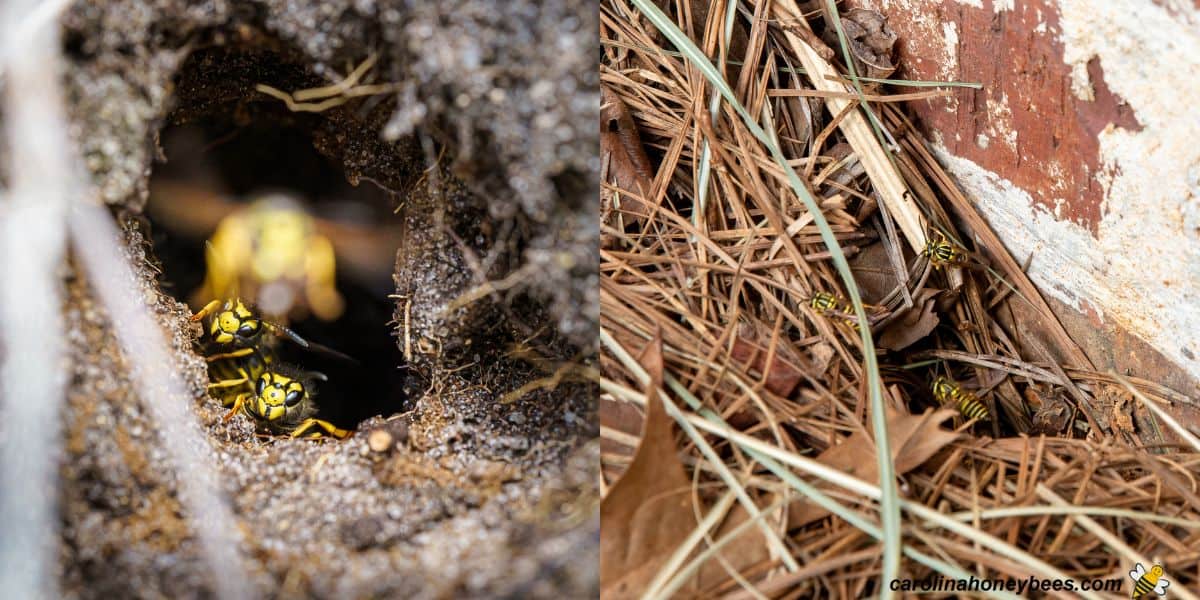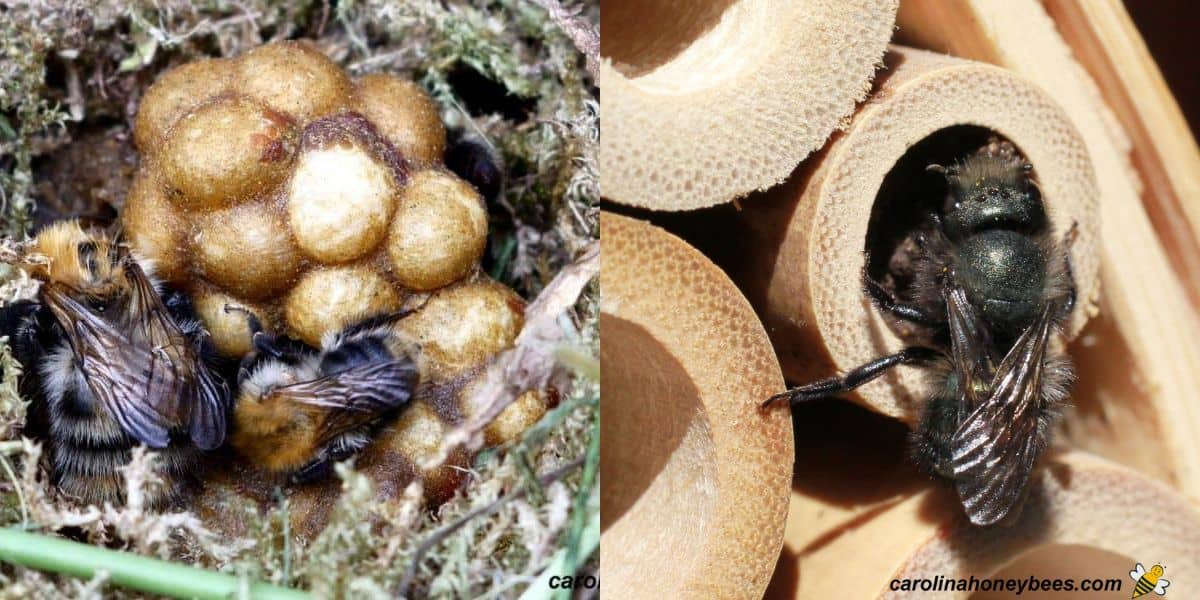Bee Nest vs Wasp Nest
As a beekeeper, I often offer advice on identifying bee nests and wasp nests. This is important information for beekeepers or any outdoor enthusiast. Bee nests differ significantly from wasp nests in structure and appearance. Here, I will clearly explain these differences to help you know how to deal with each situation.

A nest by common definition is a place where young insects are being raised. One of the most interesting facts about honey bees is their large family units. But, nesting practices vary among species – you might walk by someone’s home and never notice it.
Identifying Nest Sites
Seeing a group of insects close together in one location seems to indicate a nest. But, not every congregation of insects is a nest. They may simply be feeding on nectar-rich flowers or insect secretions to make honeydew honey.
Learning how to recognize and tell the difference between bees and wasps and their nests is important. In my experience, it helps you know the safety zone.
A nest is a place where food is stored and young are raised. But, it is a wise idea to respectfully stay away from any type of bee nest.
In general, wasps are more defensive than bees and will respond quickly to intrusion upon their space. However, even the docile honey bee will sting to defend their home.
I have had to move away from beehives quickly many times. Perhaps you don’t intend harm – but they do not know this.

How to Identify the Differences
Below, I will explain how to identify the difference between bees nests and wasp nests – including the aggressive Yellow Jacket Wasp. If you have any questions, please let me know in the comments section.
There are several factors used to identify the type of nest we see. Begin by looking at the residents. Can you identify a honey bee or wasp-from a safe distance of course?
You may be able to see them actually on the nest or coming and going from the entrance.
Honey Bees Nest

Most honey bees live in large colonies inside cavities. They are often found in a hive provided by a beekeeper, or you might see a wild colony of honey bee nesting in a hollow tree.
Sometimes, they choose other enclosed spaces such as the walls of a home. This can be a big problem because a beehive is not seasonal. Honey bees survive Winter as a large family unit.
If nothing causes them to die, they will still be there next year… and so on. Homeowners often pay a lot of money to have honey bees removed from their house.
Female worker bees make beeswax with special glands on the underside of their abdomen and construct sheets of honeycomb. These are used to store food and rear young.

Wasp Nests
The most common nests I find in and near my home are wasps’ nests. A small grey oval structure hanging from the eaves of a roof or old building with a few protective wasps on the surface is common.
Early in the season, they are very small. But, they can grow rather large. Over the Summer months, I have seen them reach a width of 6″ and more.
Wasps may build a nest inside a closed cavity but most of these nests are in the open – exposed and easy to see.
Yellow Jacket Wasp Nest
Another member of the wasp family that is common – is the Yellow Jacket Wasp. This insect is commonly misidentified as a honey bee. But, honey bees and yellow jackets are very different.
Yellow Jackets routinely live in the ground (in general, honey bees are not ground dwellers). Yellow jacket nests can grow very large and are often unnoticed until mid to late Summer-when population is at its peak.

Though they serve a useful purpose in pest control, they are not one of the most loved insects. Their aggressive nature makes them a serious stinging hazard.
Likely you will not see the actual nest – only the small hole where the wasps can be seen coming and going.
If you can not (or do not want to) destroy the nest, mark it clearly and advise everyone to stay far away. Once Winter arrives – they will be gone.
Using yellow jacket traps early in the season may reduce the number of colonies later on – you can even make your own yellow jacket trap.
Common Bee Nest Look A-Likes
Not every type of bee or insect nest looks the same – or as we might expect one to look. Beyond our honey bees that live in a large group year-round, you may see other types of nests.

Bumble Bee Nests
You will likely never see a bumble bee nest but you might walk by one. Unlike honey bees – bumble bees often nest in the ground. They prefer burrows left by rodents etc.
This is a seasonal nest that will not grow very large and be gone by Winter. Leave these native bees in peace if you can.
Solitary Bees
You may find a solitary bee nest. Mason bees are a good example of a beneficial pollinator that often live in cracks in masonry, hollow stems or tubes provided by homeowners.
The reproductive female selects a site for a home and lays eggs. In some species, after provisioning the nest with food, she never meets her young.
This post may contain affiliate links. As an Amazon Associate, I earn from qualifying purchases. Please read my disclosure.
Top Pick
A product such as this, gives you quality hive components to start your first hive. The needed tools you would choose and buy separately. This allows you to customize the kit.
Hornet Nests

Hornets’ live in very large paper nests. Usually located high in the tree tops, you may not see them until Winter-after the leaves are off the trees. The nest will be abandoned when Winter arrives.
Hornets are very aggressive around their home and the sting hurts! Stay away – if they are not located near a human space, leave them.
Hornets do a good job of catching flies and other insect pests. Even the parasitic fly that causes – Zombie Bees may fall prey to hornets.

European Hornets Nests
We have several types of hornets around our area that do little harm. However, there is one type of hornet colony that I will destroy when found.
This is the large yellow European Hornet – similar to the Asian Hornet (Murder Hornet) but already established in the US. Like Yellow Jackets, they are predators and can be a serious predator of honey bee colonies.
They often nest inside tree cavities-though I have seen them living inside walls. Relentless in attacking honey bee colonies in mid-Summer, they are not welcomed at my home.
Key Points
Wasps build aerial nests, ground nests or nests inside cavities. Bees tend to build inside cavities (hollow trees – honey bees), (burrows – bumble bees), (hollow stems etc – mason bees).
This is a telling difference between a bee nest and a wasp nest – the wasp nest will not have beeswax. Wasps do not have wax glands and cannot make honeycomb.
Their grey nests of paper-like material are made with chewed wood. The exception is the solitary Mud Dauber wasp who builds a home with mud.
Wasps nests are only used for one season – they are not reused. When the season winds down and all the young are mature, the site is abandoned.

Honey Bee Swarm is Not a Nest
Honey bees swarm to make new colonies – half the members of the colony leave to find a new home. On their journey, they temporarily sit down in a nearby tree or bush.
Seeing this mass of bees hanging from a limb may seem to indicate the presence of a nest. This is not usually true.
In a few hours, the swarm will leave to journey to their new home. But occasionally, the swarm is unable to decide on a new site.
In this case, they begin to build comb attempting to nest in the open. If you see this happening, call a local beekeeping association to see if they can help. Most exposed honey bee nests do not survive Winter.
FAQs
Wasps collect plant fibers and materials and chew the mixture to create their grey nests.
Expect a wasp nest to be active for 3-4 months during the warm time of year. By the time cold weather arrives, the nest will be abandoned.
Honey bees do not normally nest in the ground. You are likely seeing a type of wasp, such as the Yellow Jackets wasp. They are be dangerous -stay away.
Any adults not killed may return to the nest site for a day or so. They are attracted to the pheromones left behind.
Bumble bees nest in pre-existing cavities. Often the use an empty rodent burrow in the ground or openings in rock walls. They nests are not very large and will be gone after the season.
Bees and wasps that nest for one season will not return to the nest after Winter. Honey bees typically maintain any active colony year round. If you need honey bees removed, call a beekeeper.
Types of nesting habits include: ground nesters (build nesting in holes in the ground), wood tube nesters (use hollow tubes or plant stems), and cavity nesters (construct homes inside open cavities) such as honey bees that build wax comb inside hollow tree trunks.
Some folks have an true intense fear of bees (apiphobia). This often results in a call to destroy these nests. Nest should only be destroyed in situations where human safety is an issue.
Even a bee friendly garden can benefit from having a few predator wasps around. This helps balance out the ecosystem.
A Final Word
Whether you see a bee nest or a wasp nest, you are seeing the next generation of these beneficial insects. Sometimes they must be destroyed for public safety.
Here on my little homestead, we do destroy nests that are large and near areas where we walk a lot. However, those that are high in the eves of the barn are left to provide some insect control.
Seek professional help in removing honey bee colonies especially in regions with Africanized (killer) bees. As for the other types of nests, try to leave them alone and let nature take its course.




